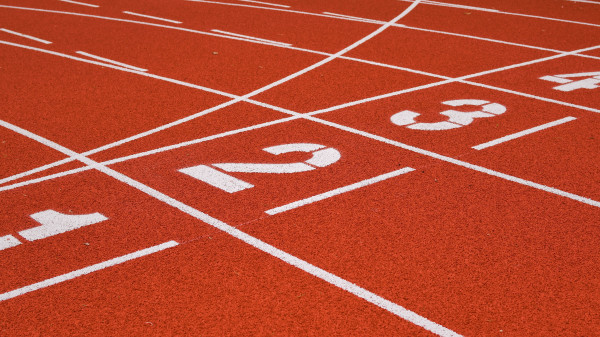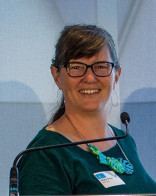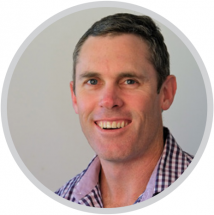Issue 68 | Sport and Eating Disorders
NEDC e-Bulletin
Contents:
Q&A interview with Shane Jeffrey
Video interview with Fiona Sutherland

Editor’s Note:
Welcome to the NEDC e-Bulletin: Sport and Eating Disorders.
In Australia, sport plays an important role in people’s lives from childhood onwards. That can include taking part in school sports carnivals, joining a local footy or netball team, earning swimming certificates, or just playing beach cricket. For some people, sport can lead to a career as a professional dancer, high-performance athlete, or member of an elite team. Eating disorders are estimated to affect approximately 9 per cent of the total population, and there is a higher prevalence of disordered eating and eating disorders in athletes compared to non-athletes.
NEDC National Manager Hilary Smith worked with the Australian Institute of Sport (AIS) for more than two years to jointly produce a position statement on disordered eating in high performance sport accompanied by a toolkit of resources. The new website was launched this month. Find out more about this project here.
For this sport-themed issue, we interviewed Accredited Practising Dietitian and Accredited Sports Dietitian Shane Jeffrey about specific risk factors, effective treatment approaches, and how dietitians can help people playing all skill grades, from a community level to competition. Read the Q&A here.
We also interviewed Accredited Practising Dietitian and Accredited Sports Dietitian Fiona Sutherland for her perspective on how to start the conversation about disordered eating, raising awareness, and her work with The Australian Ballet School. Read the article or see the video interview here.
This issue also provides an update on events.

AIS-NEDC launch
NEDC has been working in partnership with the Australian Institute of Sport (AIS) to improve prevention, identification and management of disordered eating and eating disorders among Australia’s High Performance Sport sector. The High Performance Sport System includes National Sports Organisations, State and Territory Institutes of Sport, and Olympic, Paralympic and Commonwealth Games partners. The AIS leads system development and improvement for all of these organisations; it has been wonderful to be able to work alongside them to address the issues of disordered eating and eating disorders in elite athletes.
Disordered eating and eating disorders can occur in any athlete, in any sport, at any time, crossing boundaries of gender, age, body size, culture, socio-economic background, athletic calibre and ability. In the High Performance system, we know that some of the personal factors that can contribute to a successful athlete, such as perfectionism and obsessive traits, can also raise their risk profile for the development of an eating disorder. In addition, an environment in which there is pressure to maintain meticulous control of body composition may contribute to an increased prevalence of disordered eating and eating disorders.
NEDC and the AIS have jointly produced a position statement on disordered eating in High Performance sport. This position statement supports the prevention and recognition of disordered eating and eating disorders, and promotes early intervention. Its focus is on ensuring that athlete nutrition is managed in a safe, supported, purposeful and individualised manner, and that athlete mental and physical health are prioritised above performance goals. The practical recommendations in the position statement are intended to guide the identification and clinical management of disordered eating in Australian High Performance sport, as well as eating disorder prevention through the development of a healthy sport system. The position statement has been written for athletes, coaches, support staff, clinicians and leaders of sporting organisations – everyone has a role in preventing and responding to disordered eating and eating disorders among athletes.
To complement the position statement, a range of resources has been created to support coaches, support staff, clinicians and High Performance sporting organisations to improve the early identification and prevention of disordered eating in High Performance athletes. NEDC and AIS are also continuing to work together to develop COVID-safe delivery options for Eating Disorders in Sport (EDiS) education sessions for High Performance Sport Organisations, to improve skills, knowledge and confidence in early identification and prevention of eating disorders for coaches and performance support staff.
If you are involved in High Performance sport, these resources are for you. If you’re interested in eating disorders in sport more generally, please refer to our other resources on the NEDC website.
See the AIS-NEDC pre-launch webinar here.

NEDC National Manager Hilary Smith

Q&A interview with Shane Jeffrey:
We interviewed dietitian Shane Jeffrey, who has more than 25 years’ experience in the eating disorders sector, to understand the links between disordered eating and sport.
Do you see many sports people who are also living with an eating disorder? What are the risk factors for eating disorders in sports people?
I would say about 20-30 per cent of my case load is sports people living with an eating disorder, ranging from recreational sport through to those competing at a national and international level. The majority of these cases would be aged between 14 and 30 years of age, and participating in a wide range of sports. Of interest, we have also seen a number of Masters athletes as well.
The risk factors for sports people developing an eating disorder encompass the usual biopsychosocial factors, with an overlay of sport specific risk factors. A number of high risk time points for sports people include injury, retirement, puberty/adolescence, body composition and weight monitoring and changes in these parameters, variations in training load (e.g. transitioning to the off season), and moving between levels of competition (e.g. selection and deselection) to name a few. It is also known that young athletes who commence sport specific training are at a higher risk of developing disordered eating and eating disorders. Other risk factors that sometimes get overlooked are those associated with coaching behaviour, sporting culture, and the rules and regulations of specific sports.
How do you see your role as a dietitian in helping sports people of every skill level who are also living with eating disorders?
When I am working with sports people, I like to build an understanding of the person’s perspective of their sport-associated goals and why these might be important to them. My role then is to collaboratively establish strategies for linking these sport-specific goals with the goals of nutrition for sport performance. This might involve exploring the impact on both health and performance of a relative energy deficiency, and how modifying the nutritional goals can contribute to improved health and performance. Another role integral to this work is to explore the idea of a multi-disciplinary team being established to assist with treatment, including referral to evidence-based eating disorder treatment approaches. It is my experience that many athletes seeking assistance are not aware of the presence or significance of an eating disorder, so the seeking of diagnostic clarification can be beneficial, in which case onward referral is necessary. Working with the person to re-establish and re-connect with food decisions based on their values is also an important part of work in this space, and I often use this as an alternative to step back from the detail of a prescriptive meal plan – on which in my experience, many athletes become overly obsessed.
What have your clients taught you about effective treatment approaches for people engaged in sport who also have eating disorders?
Ah, clients – I always think of them as my greatest teachers, and often view my sessions as an opportunity for professional development as I believe we can learn so much from the people we work with. I think the greatest learning has to tie the nutritional interventions into the person’s sporting goals and aspirations (the non-eating-disorder-focused ones anyway), and for this reason we focus on the principles of sport nutrition and sports performance as a way of developing leverage for dietary change. I remember some time ago when I used to treat a sports person in a similar manner to a non-sports person and realised that I had poorer engagement and greater treatment dropout; this changed when the context of their sport was kept in mind during the treatment process – yielding better engagement and better treatment outcomes. In summary, don’t forget that the person in front of you is also a sports person, so treat the person, not just the diagnosis.
What are some performance, training or injury complications for people engaged in sport who are also living with an eating disorder?
To best answer this question, I would refer people to the 2018 update of the International Olympic Committee Consensus statement on Relative Energy Deficiency in sport (RED-S). This is a wonderful document that clearly outlines both in text and figures the health and performance consequences of a relative energy deficit in sport. To me, this document is akin to how we reference to the Keys Starvation study in our eating disorder work – and as such, I often provide it to the sports people I work with as a point of raising awareness, education, and opening up opportunity for discussion. In my experience, RED-s is seen across a range of eating disorder diagnoses, and should not be limited in its application to anorexia nervosa. The research supports that performance is reduced, training compromised due to inadequate preparation and recovery, and the risk of injury increased – with people being both at a greater risk of injury and the time to recovery from injury prolonged. With this in mind, the implications of an eating disorder in the sporting space are significant, and should be taken seriously and addressed as early as possible.
What risk reduction strategies do you recommend? How can a dietitian help a person taking part in sport at any level, from competition to recreational?
I think risk reduction is a complex area that sits in many spaces. It could be reducing the risk by reviewing the culture of a sport or an organisation at all levels, introducing some screening tools for athletes to complete, or by changing a number of processes that might relate to key areas such as weight monitoring and body composition measures for example. There is so much that can be done in this space. Having said that, my main risk reduction strategy is to encourage people to look after their body in a similar way to what they would look after another person’s – I find this helps the person to cut through the eating disorder noise and connect with their values-based nutrition beliefs which are often aligned with the direction of treatment.
I believe that in the world filled with an overload of information regarding nutrition and sports performance, a dietitian can play an integral role for sports people of all levels, and in these cases I would strongly recommend an accredited sports dietitian – which is a dietitian who has undertaken additional training in the field of sports nutrition. Sports dietitians can advise on things like nutritional adequacy, macronutrient distribution, recovery nutrition and provide practical ideas for integrating these principles into day-to-day life. You know, it often baffles me that people go to the gym or train hard in some other way without complementing this with some general sport nutrition principles.
As a keen cyclist, long distance runner, triathlete and coach as well as a dietitian, what would be your chief recommendation?
My chief recommendation here is to keep it simple and recommend the RAVES model – eat Regularly (distribution matters), eat Adequately (and avoid relative energy deficiency), eat a Variety of foods (all foods can be included – it’s the context, the amount, and frequency of eating any food that matters), Eat socially (because life involves celebrating food with others), and be Spontaneous (flexibility provides freedom)
With my sports people, I usually start with RAVES and have the goal of getting these core principles in place before we fine tune and add the detail. It doesn’t have to be prescriptive or overly detailed, but the introduction of some key principles can really make a difference – start broad and fine tune as needed. And a final recommendation – aim to enjoy the food you eat!

Shane Jeffrey is the Director of River Oak Health and Food Mind Body, two Queensland-based private practices of dietitians dedicated to the treatment of eating disorders and weight concerns. Shane has a strong interest in prevention and treatment of eating disorders in sport, and the management of exercise in the eating disorders. Shane has provided consultation to national and state-based sporting organisations, and welcomes the recent release of the The Australian Institute of Sport and National Eating Disorders Collaboration position statement on disordered eating in high performance sport.

Video interview with Fiona Sutherland
Accredited Practising Dietitian and Accredited Sports Dietitian Fiona Sutherland has been practising for over 15 years. She also works with emerging professional dancers at The Australian Ballet School and has worked with the AFL earlier in her career.
Ms Sutherland describes her role as a combination eating disorder and sports specialist, which has given her valuable insights in treating high-performance and elite sportspeople.
“I was always very interested and passionate in sports, Ms Sutherland said.
“When I began working with high-performance athletes, I found that I was able to pick up on some of the early warning signs or signals of disordered eating patterns or disregulation they were demonstrating or difficulties with mood or in their relationships with food that I think under other circumstances I don’t think I would have picked that up.
“My work in eating disorders dovetailed really nicely with my work for example with footy, with cricket or with ballet. That intersection fit very naturally for me.”
Starting the conversation
Ms Sutherland says opening up the conversation about disordered eating and eating disorders in sporting organisations is a difficult task but an essential one.
“In the sports setting it is often masked, because … disordered eating can look like someone who’s very committed and very dedicated as an athlete,” she said.
“It can be tricky and it can be uncomfortable when you’re having these conversations with organisations,” she said. “Maybe they don’t see these symptoms as part of a spectrum, rather they see it as part of being an athlete.”
Ms Sutherland says one athlete in a group showing signs of an eating disorder is usually just the tip of the iceberg, with more athletes or team members also engaging in disordered eating not being picked up because they haven’t shown overt signals such as medical instability, significant reduction in performance or weight loss or weight fluctuations.
“In my experience an athlete becomes really quite unwell, (then) all of a sudden the team or the organisation, their attention is drawn straight to this particular issue,” she said, adding that she wished it didn’t happen that way.
“I do think we need to stay on the front foot and to help organisations take this seriously before people get unwell,” she said.
Increasing awareness
Ms Sutherland said that, paradoxically, increased awareness can lead to the unhelpful narrative that “if we talk about it makes it worse”. Since silence, shame and stigma are the “best friends” of an eating disorder, that couldn’t be further from the truth. Implementing screening tools, pathways of care, and reporting red flags can look like things may be getting worse, but she said that was not true and instead a sign that the prevention model is doing what it’s meant to do – picking up people in difficulties in early stages and hopefully avoiding deeper territory.
“(It) doesn’t make it worse but what happens is you see things that have always been there but that haven’t been picked up on,” Ms Sutherland said.
Positives of sport
Sports participation generally can be broadly protective for most people’s physical and mental health but there are risks in aesthetic and weight-category sports.
“For most people (sport) is a fantastic way to engage socially, to move your body in ways that feel good, have that camaraderie, feel strong and energetic and community oriented no matter what level you’re participating at,” she said.
But she added we also need to be aware that disordered eating and eating disorders “can happen in any sport, any age, any gender, any stage of development”.
Role of the dietitian
Ms Sutherland believes dietitians can play an integral role in prevention, early intervention and in the treatment phase.
“Not just writing a meal plan and education about nutrition,” she said. “There’s so much more than that.”
Ms Sutherland says building on trust and rapport can support a person’s transition away from disordered eating behaviours, thoughts and feelings.
She said dietitians can allay fears and support athletes to fuel their body from a place of care, by understanding them as people as well as athletes and understanding performance goals.
“Eating disorders and optimal performance do not go together at all,” she said.
Working with The Australian Ballet School
“It is a huge gift to work there and to have so much interaction with these really quite brilliant young people in so many ways - so impressive on so many levels,” Ms Sutherland said.
“I try to honour their high level of commitment and dedication and also remember they are a human being first. I think that about all my clients anyway – see the person first.”
Ms Sutherland said her work with ballet dancers taught her persistence, the importance of understanding, rapport and avoiding distraction.
COVID-19 challenges
For an entire cohort of elite sportspeople and performers, missing out on opportunities to take part in such events as the Olympics, high-level international competitions and tours can be devastating. This is true also at a community level.
“Loss and grief associated with loss of opportunities is palpable,” Ms Sutherland said, noting that the pandemic and its associated challenges won’t end on December 31.
She said this had affected people differently, even sometimes within the same team.
Importance of research
Ms Sutherland believes discovering the evidence base behind eating disorder treatments was very important to her career in dietetics.
“Research into eating disorders is essential because unless we have research we don’t know what is effective and what isn’t,” she said. “We have to do the best we can with what we’ve got.”
“One of the things I love about eating disorders is there’s not one way to get well and there’s not one way to be an eating disorders dietitian,” she said. “People can get well in lots of different ways.”
Fiona Sutherland is director of The Mindful Dietitian and has been practising as a dietitian for over 20 years primarily in the areas of eating behaviour, eating disorders, body image, sports nutrition & education/training. She is host of the Podcast “The Mindful Dietitian” and a Sports Dietitian, consulting at The Australian Ballet School and national sporting organisations. She also teaches across Masters Level Dietetic training programs at several different universities in Melbourne and is a mindfulness practitioner and yoga teacher.

Update on events
COVID-19 has put the brakes on many conferences, seminars and training events but there are still some professional development opportunities available in person, particularly in states less badly affected by the pandemic. Many other events have been reconfigured and moved to an online format.
To find out what’s happening in the eating disorders sector around Australia, click here.
« Back to Browse Resources

